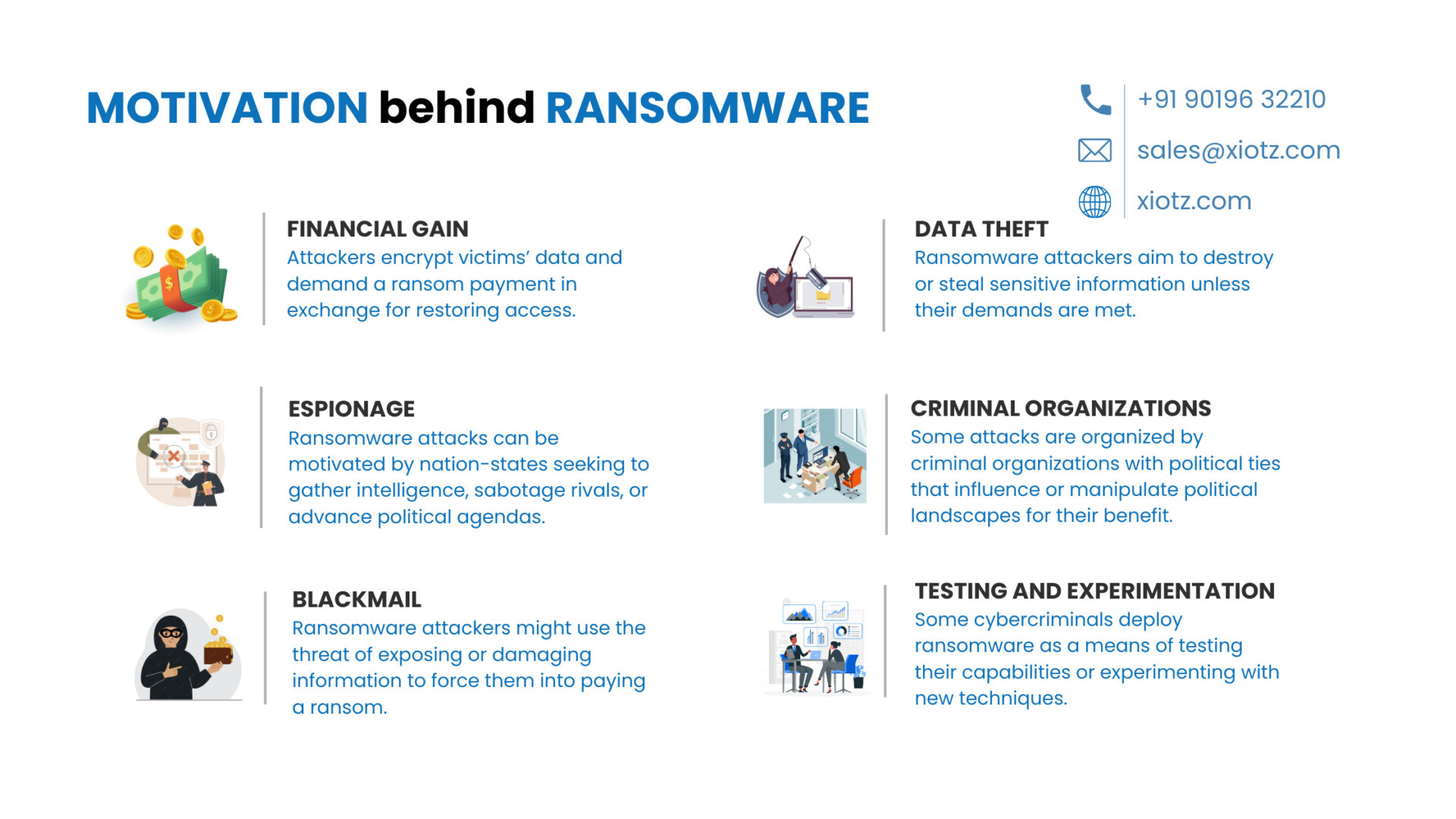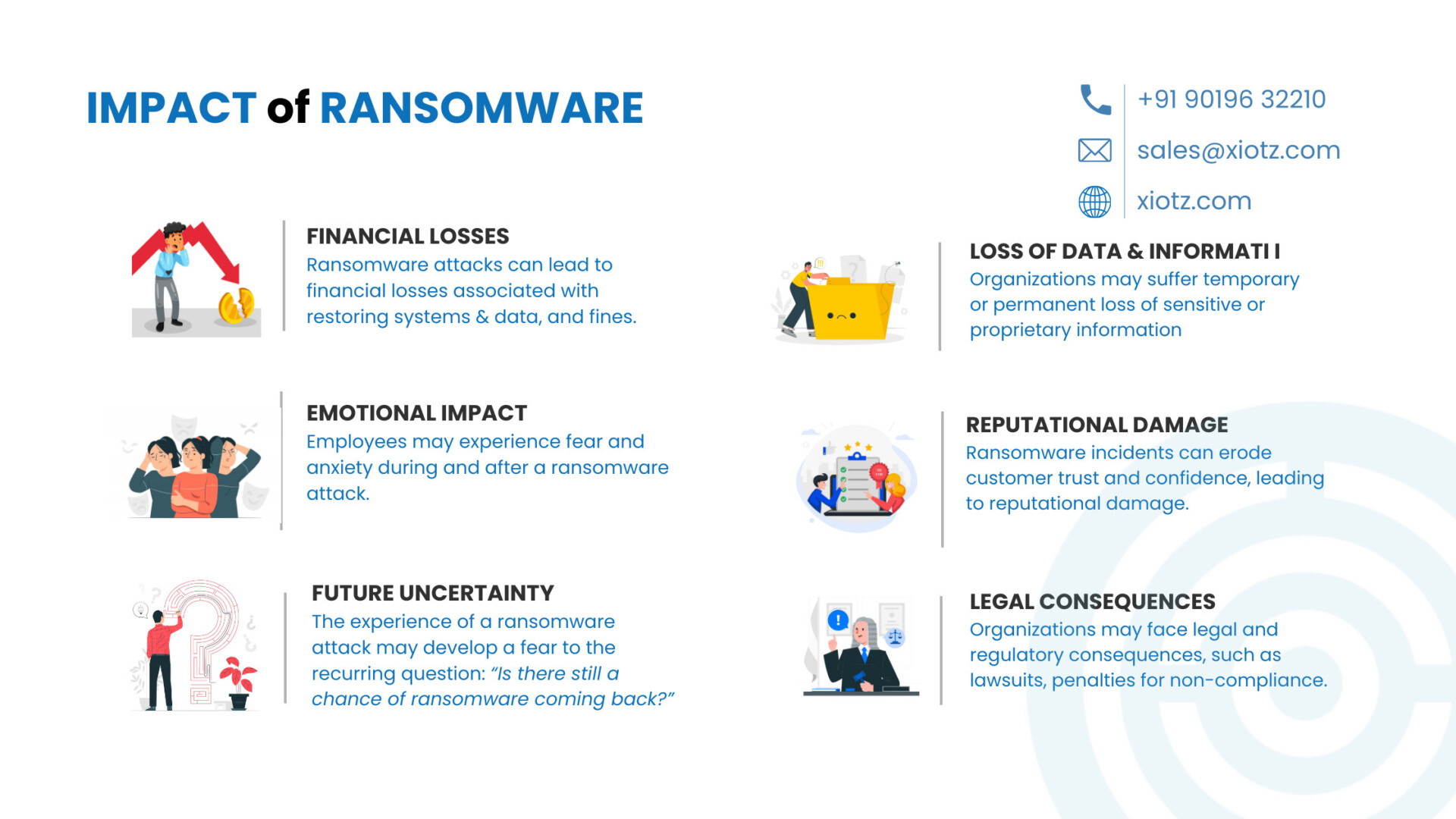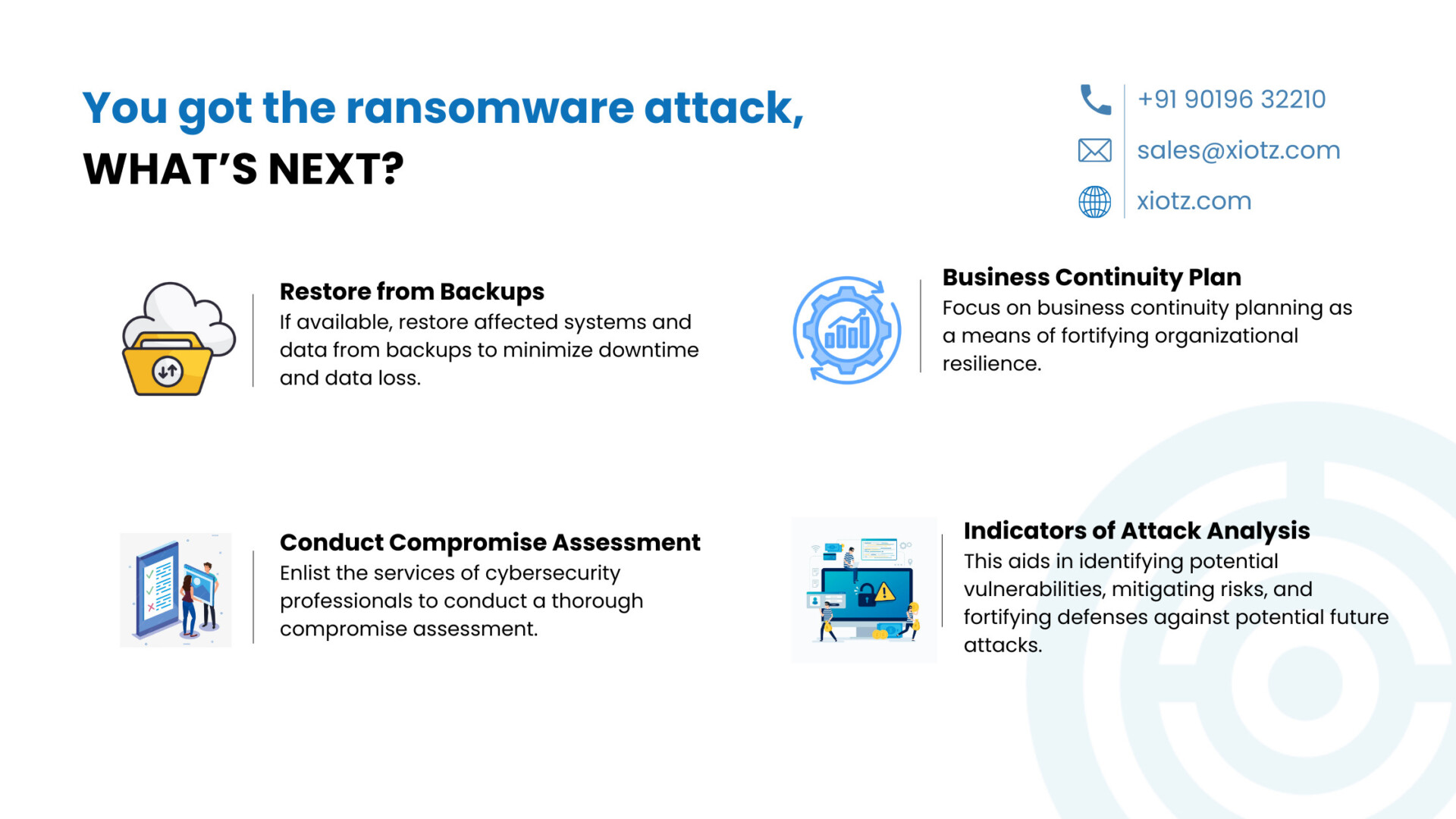Table of Contents
Ransomware: Attacks and Strategies
What is Ransomware?
Ransomware is particularly a type of malware used by cybercriminals. If a computer or network has been infected with ransomware, it blocks the access to the system or encrypts its data. Cybercriminals demand ransom money from their victims significantly in exchange for releasing the data.
Ransomware is on the rise.
- Cybersecurity Ventures predicts that by 2031, ransomware will cost victims $265 billion annually, up from $20 billion in 2021, and it will attack one business every 2 seconds, up from every 11 seconds in 2021.
- 66 percent of surveyed organizations specifically say they were hit by ransomware in the last year.
- IBM Cost of a Data Breach Report 2023 evidently finds that the global average cost of a data breach is $4.45 million.
Types of Ransomware
There are several types of ransomware attacks but most common attacks are these two:
1. Locker ransomware:
- This type of malware particularly blocks basic computer functions. For example, you may be denied access to the desktop, while the mouse and keyboard are partially disabled. This allows you to continue to interact with the window containing the ransom demand in order to make the payment.
- Apart from that, the computer is inoperable. But there is good news: Locker malware doesn’t usually target critical files; it generally just wants to lock you out. Complete destruction of your data is therefore unlikely.
2. Crypto ransomware:
- The aim of crypto ransomware is to encrypt your important data such as documents, pictures and videos, but not to interfere with basic computer functions. This spreads panic because users can see their files but cannot access them.
- Crypto developers often add a countdown to their ransom demand: “If you don’t pay the ransom by the deadline, all your files will be deleted.” and due to the number of users who are unaware of the need for backups in the cloud or on external physical storage devices, it can have a devastating impact.
- Consequently, many victims pay the ransom simply to get their files back.

3. Scareware:
- Scareware refers to malicious software or deceptive tactics that present false claims of security risks or illegal activities on a user’s computer.
- The primary goal of scareware is to create fear or anxiety in users by displaying misleading warnings or pop-ups. These warnings may falsely suggest the presence of malware, viruses, or legal issues, pushing users to take immediate action, such as purchasing fake antivirus software or paying a ransom.
4. Leakware:
- Leakware particularly threatens to expose sensitive or confidential information unless the victim pays a ransom.
- The main objective of leakware is to exploit the fear of data exposure. Attackers may claim to have accessed sensitive data, such as personal information, financial records, or business secrets, and threaten to make this information public unless the ransom is paid.
What is the MOTIVATION behind ransomware?
- Financial Gain: Many attacks are driven by the desire for monetary profit. Attackers encrypt victims’ data and demand a ransom payment in exchange for restoring access. The financial motive remains a primary driver for many cybercriminals.
- Disruption: Some attackers seek to disrupt organizations, governments, or critical infrastructure for political or ideological reasons. Ransomware attacks can cause significant disruptions to operations, leading to reputational damage or financial losses.
- Data Destruction or Theft: In some cases, attacks may aim to destroy or steal sensitive information. Attackers may threaten to release confidential data unless their demands are met, leveraging the fear of data exposure to extort victims.

- Espionage and Nation-State Agendas: These attacks can be motivated by nation-states seeking to gather intelligence, sabotage rivals, or advance political agendas. This includes using ransomware as a covert tool in geopolitical conflicts.
- Criminal Organizations: Some ransomware attacks are organized by criminal organizations with political ties that influence or manipulate political landscapes for their benefit.
- Blackmail and Extortion: Ransomware attackers might use the threat of exposing embarrassing or damaging information about individuals or organizations to force them into paying a ransom.
- Cyber Warfare: Ransomware serves as a tool in cyber warfare, targeting military systems, energy grids, and essential services to make chaos in technological infrastructure and disrupt a nation’s functioning.
- Testing and Experimentation: Some cybercriminals deploy ransomware as a means of testing their capabilities or experimenting with new techniques.
What is the IMPACT of ransomware in an organization?
Ransomware can have significant impacts on organizations, including:
- Financial Losses: It can lead to financial losses due to extortion payments, costs associated with restoring systems and data, and potential fines or legal fees.
- Disruption of Operations: Ransomware can disrupt regular business operations, causing downtime that affects productivity and revenue generation.
- Loss of Data and Information: Organizations may suffer temporary or permanent loss of sensitive or proprietary information, impacting their competitiveness and reputation.

- Emotional Impact: Employees may experience fear and anxiety during and after a ransomware attack, impacting their emotional well-being. The persistent doubt of whether the organization is still under the threat of ransomware can contribute to ongoing emotional distress.
- Reputational Damage: Ransomware incidents can erode customer trust and confidence, further leading to reputational damage that may affect long-term relationships and brand value.
- Future Uncertainty: The experience of a attack may instill a fear of leading to the recurring question: “Is there still a chance of ransomware coming back?” This particularly creates a constant concern about future cyber threats.
- Legal and Regulatory Consequences: Organizations may face legal and regulatory consequences, such as lawsuits, penalties for non-compliance, and damage to their public image.
Okay so, now we know the motive and impact of ransomware but…
You got the ransomware attack, WHAT’S NEXT?
After experiencing a ransomware attack, here are steps to take:
- Disconnect All the Wires: Quickly pull the plug on affected systems! Isolate the infected devices to stop the ransomware from spreading its nasty infection.
- Alert Authorities: Report the attack to appropriate authorities, such as law enforcement or cybersecurity agencies.
- Engage Incident Response Team: Activate the organization’s incident response team or engage external cybersecurity experts to assess the situation and guide the response efforts.

- Record Details: Document all pertinent information about the attack, including when it occurred, how it was discovered, and any ransom demands.
- Implement Recovery Plan: Execute your organization’s ransomware response plan to initiate recovery efforts promptly.
- Restore from Backups: If available, restore affected systems and data from backups to minimize downtime and data loss.
- Enhance Security Measures: Strengthen cybersecurity defenses to prevent future attacks, including updating software, enhancing employee training, and implementing advanced security solutions.
- Work on Business Continuity Plan: Focus on business continuity planning as a means of fortifying organizational resilience. Ensuring seamless operations during and after an attack is pivotal for sustained business functionality.

- Conduct Compromise Assessment: Enlist the services of cybersecurity professionals to conduct a thorough compromise assessment. This proactive measure aims to identify and neutralize any latent threats within the network.
- Indicators of Attack Analysis: Undertake a detailed analysis of Indicators of Attack (IoAs). This methodical approach aids in identifying potential vulnerabilities, mitigating risks, and fortifying defenses against potential future attacks.
10 Biggest Ransomware Attacks in History
Rank | Attack Name | Year | Attack Type | Notable Targets | Estimated Damage | Key Detail |
1 | ExPetr / NotPetya | 2017 | Ransomware (wiper) | Maersk and Merck | $10 billion | Exploited an SMB vulnerability, designed for destruction. |
2 | WannaCry | 2017 | Ransomware (SMB vulnerability) | Global attack | $4 billion | Used EternalBlue, affected 200,000+ computers. |
3 | GandCrab | 2018-2019 | Ransomware-as-a-service (RaaS) | Various | Over $2 billion | Ransomware sold to affiliates, primarily spread through phishing. |
4 | Locky | 2016-2018 | Ransomware (phishing emails) | Healthcare providers | $1 billion | Delivered via malicious Word documents, targeted healthcare. |
5 | Ryuk | 2018-present | Ransomware (usually via TrickBot) | Various | Over $150 million | Manually deployed, extensive network compromise before encryption. |
6 | REvil/Sodinokibi | 2019-2021 | Ransomware (exploited vulnerabilities) | Kaseya, JBS | Double extortion, attacked Kaseya supply-chain. | |
7 | DoppelPaymer | 2019-present | Ransomware (spear-phishing) | Various | Tens of millions | Manually delivered, uses multi-threading for faster encryption. |
8 | SamSam | 2016-2018 | Ransomware (manual deployment) | Healthcare and government sectors | Over $6 million | Manually deployed, targeted healthcare and government sectors. |
9 | NetWalker/UCSF | 2020 | Ransomware (phishing, VPN vulnerabilities) | University of California, San Francisco | Tens of millions, $1.14 million ransom from UCSF. | |
10 | Colonial Pipeline | 2021 | Ransomware (phishing, VPN exploitation) | Colonial Pipeline | $4.4 million in Bitcoin | Largest publicized cyber-attack on US critical infrastructure. |
Backup Your Data with a 3-2-1-1 Strategy
3: Store 3 copies of data — specifically 1 original plus 2 backups.
2: Store data particularly on at least 2 types of storage media.
1: Particularly store 1 copy of data remotely.
1: Store 1 copy of data in significantly an air-gap isolation zone.
Three Copies of Data: First and foremost, make three copies of your data. This ensures that you have multiple backups at your disposal, so even if one becomes compromised, you still have two others as a safety net.
Two Different Media Types: Store your backups on two separate media types. For example, use both cloud storage and external hard drives. Please don’t consider the combination of an internal disk and a USB disk to be different media types. A USB drive is just as vulnerable as the internal disks. Multiple disk-based copies are only using one type of media. Consider Cloud and Tape solutions for the second backup media. 
One Copy of Data in an Off-site Location or Remotely: Keep one of your backups off-site. This means that even if your primary location falls victim to a ransomware attack or other disaster, your data remains safe and accessible. Consider using a secure, remote backup service for optimal protection.
One Air-Gapped Backup OR one copy of backup stored on Immutable Media: One backup copy of your data must be immutable. Immutable backups are saved in a write-once-read-many-times (WORM) format that can’t be altered or deleted, even by hackers or admins.
Prevention & Management of Ransomware
Ransomware attacks are widespread and harmful. They lock your data and demand a ransom. The first question arises:
How did this ransomware came?
Ransomware often gains entry into systems through vulnerabilities. Vulnerabilities are weaknesses or flaws in software, systems, or networks that can be exploited by cybercriminals.
Vulnerabilities may include:
- Unpatched Systems
- Outdated Software
- Weak Configuration
- Phishing Attacks
- Lack of Network Segmentation
How xIoTz can help up with ransomware?
xIoTz Cyber Assurance Platform plays a crucial role in mitigating the impact of ransomware and enhancing an organization’s overall cybersecurity posture. Here’s how xIoTz can help with ransomware:
1. Vulnerability Assessment:
- xIoTz conducts a thorough vulnerability assessment to identify weaknesses in your system and provide enhanced network visibility.
- Its Security Information and Event Management (SIEM) collects and analyzes data, identifying suspicious activity that may indicate potential vulnerabilities.
2. Vulnerability Management:
- xIoTz implements a robust vulnerability management strategy by utilizing AI and machine learning algorithms to proactively detect both known and emerging ransomware threats.
- By identifying and patching vulnerabilities, xIoTz significantly reduces the attack surface and minimizes the risk of successful exploitation.
3. Patch Management:
- xIoTz ensures your systems are up-to-date through timely patching and provide 24/7 continuous monitoring coverage for your network.
- It alerts you to suspicious behavior, even outside traditional business hours, allowing for immediate response and patching to prevent ransomware attacks.
4. Hardening:
- xIoTz strengthen your security posture through system hardening.
- xIoTz assists in configuring systems securely and adhering to CIS Benchmarks, minimizing security gaps and making it more challenging for ransomware to breach your defenses.
xIoTz’s CCA – Continues Compromise Assessment:
xIoTz is the only cyber assurance platform that performs Compromise Assessment. This involves evaluating the extent of a potential compromise in your system. By conducting a thorough analysis, xIoTz helps you understand the impact of a compromise, facilitating effective incident response and future prevention strategies.
Conclusion
Ransomware is specifically malicious software that is a common threat in today’s world. It closes computer access and significantly encrypts data. Ransomware attacks will increase at a cost of $265 billion per year by 2031.
The xIoTz Cyber Assurance Platform plays a crucial role in mitigating ransomware impact through Vulnerability Assessment, Vulnerability Management, Hardening, Patching and Continues Compromise Assessment
A 3-2-1-1 approach for protection is particularly recommended. It is also important to know the largest ransomware attacks in history to keep us safe from future attacks .
Related Blogs:
The Dark Side of Technology: Cyber Terrorism Attacks
The rise of Cyber Scam: How Scammers Manipulate you
Related Terms:
References:
How Can I Protect Against Ransomware? | CISA
3 Ransomware Defense Strategies
